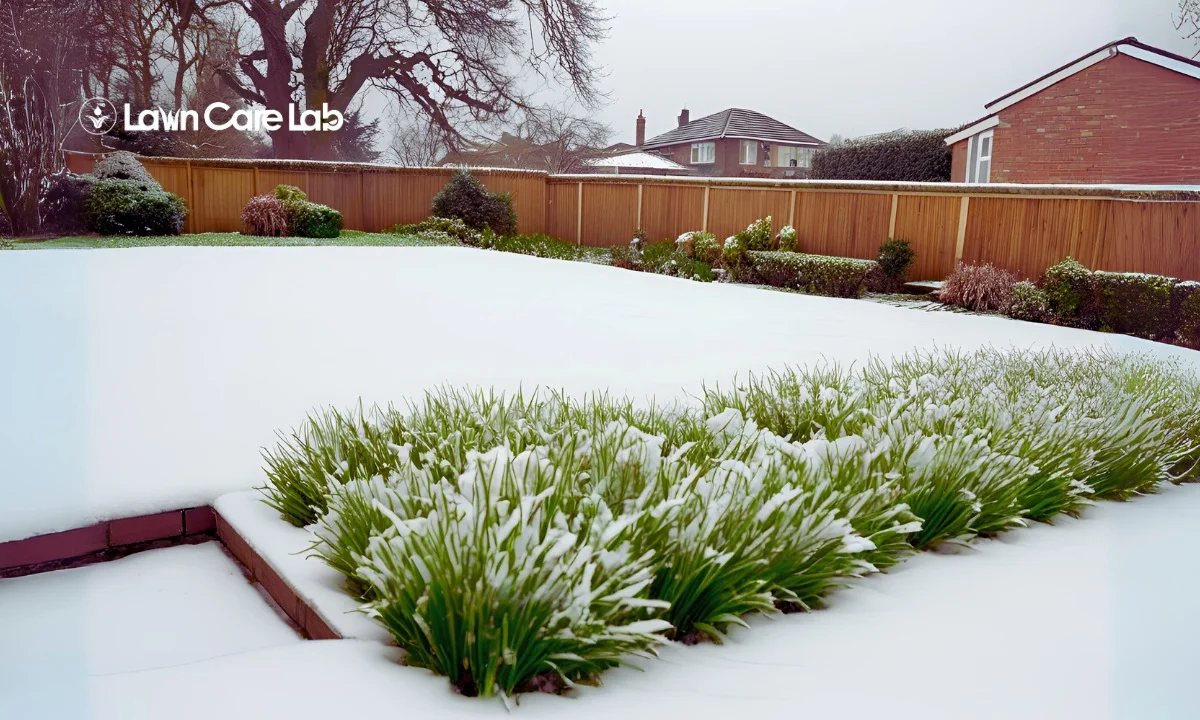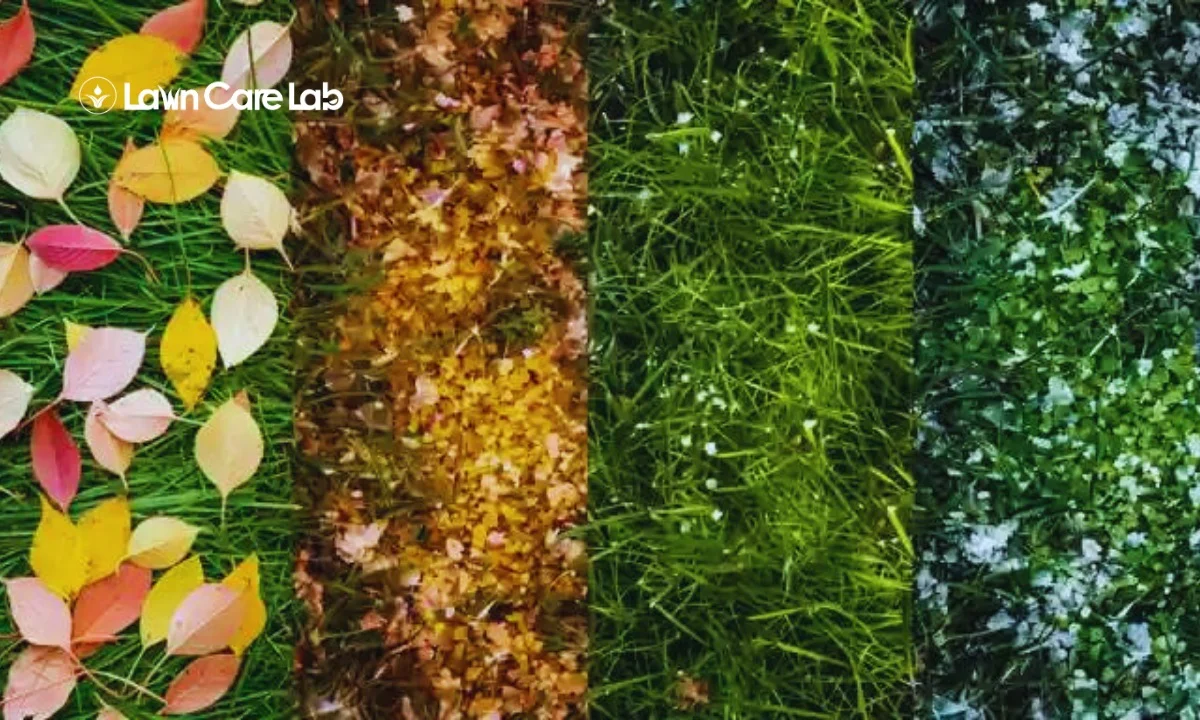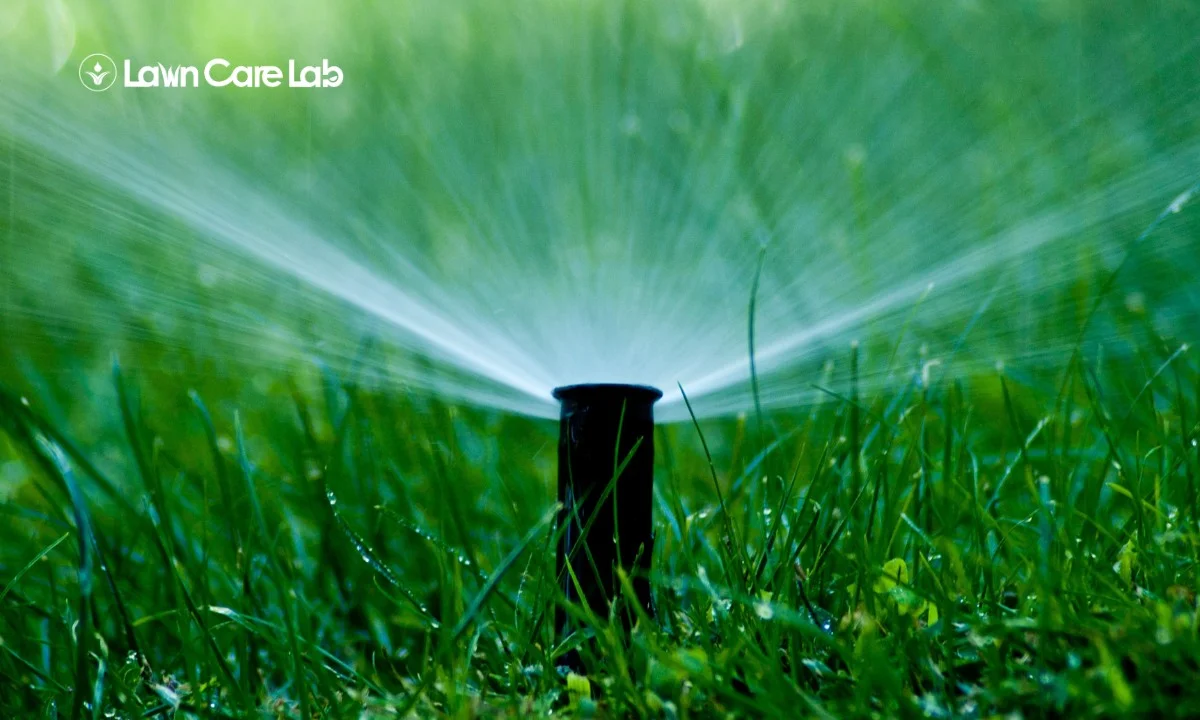Ensure your lawn doesn’t become a winter wasteland! You can maintain its green and splendid appearance throughout the year.
This detailed guide on growing and caring for grass in winter will explain why grass growth diminishes in colder months, identify winter-hardy varieties, and provide tips on planting and maintaining your lawn during frosty conditions.
Let’s help your lawn achieve lushness swiftly!
Table of Contents
Why Does Grass Growth Slow Down in Winter
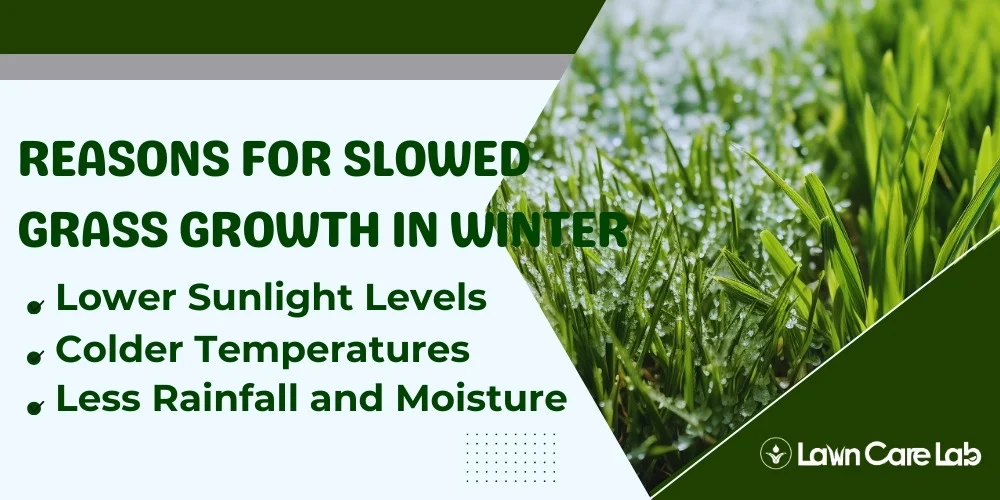
You may have observed that your lawn’s growth rate has decreased and are curious about the reason.
Winter reduces grass growth due to less sunlight, lower temperatures, and reduced rainfall or moisture.w
Lower Sunlight Levels
Here are 3 key reasons for slowed grass growth in winter’s lower sunlight conditions:
- Reduced daylight hours and weaker sun intensity limit photosynthesis, which powers growth.
- Cooler temperatures inhibit cellular enzyme activity and metabolic processes involved in growth.
- Shorter days trigger hormonal changes that signal a shift from active growth to dormancy and survival mechanisms.
The combination of decreased sunlight and lower temperatures causes grass to stop actively growing and become dormant in winter.
Colder Temperatures
- Lower temperatures inhibit enzyme activity critical for growth processes.
- Cooler soils limit nutrient and water absorption through roots.
- Repeated frosts damage leaf and stem tissues, diverting energy.
The reduced enzyme function, nutrient uptake, and frost damage from colder conditions trigger grass to halt active growth in winter.
Less Rainfall and Moisture
- Reduces water available for growth processes.
- It can trigger dormancy as an adaptive survival mechanism.
- Limits nutrient absorption from soil.
Winter drought signals grass to stop growing, conserving resources to survive dry conditions until spring.
Types of Grass That Grow Well in Winter
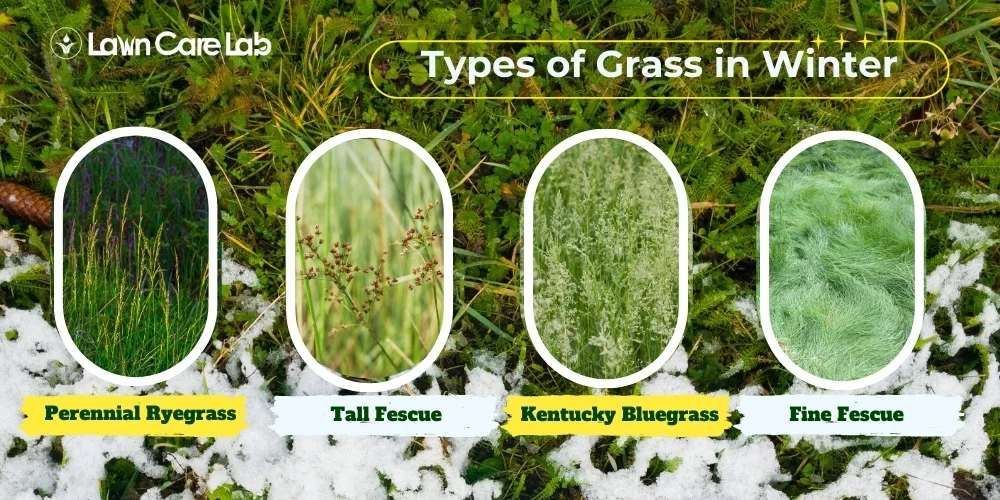
Try Perennial Ryegrass, Tall Fescue, Kentucky Bluegrass, and Fine Fescue for winter-friendly grass types.
These grass types can endure cold temperatures and frosty conditions, making them ideal for winter lawns.
Perennial Ryegrass
Perennial ryegrass is a great choice for a green winter lawn. It stays strong and vibrant even in frosty conditions, making it a top contender for winter planting.
Here are the reasons:
- Perennial ryegrass thrives in cold conditions.
- It offers excellent winter hardiness.
- It establishes quickly.
- Its dense root system allows it to access moisture and nutrients readily.
- It’s recognized as one of the most reliable winter grass seed options.
- It can withstand light frosts.
- It recovers well from icy conditions.
Tall Fescue
Tall fescue is an excellent winter grass choice due to its impressive cold tolerance and drought resistance. It maintains a healthy green color even in low temperatures and withstands frost and drought.
Consider the resilient tall fescue for your winter lawn.
Kentucky Bluegrass
Kentucky bluegrass is not just for music anymore. This durable turf is among the reliable winter grass seed types that can make your lawn appear lush when spring arrives.
Here are some facts about this resilient turf:
- It takes time to establish but is persistent. Plant the seeds in early fall and observe their resurgence in spring.
- Although it’s possible to plant grass in winter, it’s not advisable due to potential frostbite.
- Kentucky bluegrass has shallow roots, so ensure it’s well-watered before the onset of winter.
- Don’t seed grass in winter, and watering is sufficient.
Fine Fescue
Fine fescues are an excellent choice for their frost resistance.
These grasses are strong and adaptable, perfect for winter lawns as they can withstand harsh conditions and maintain their green color.
Less mowing during winter with slow-growing grass, perfect when combined with bluegrass for a beautiful winter lawn.
Now, let’s discuss some practical tips for sowing grass seed in winter.
Tips for Planting Grass Seed in Winter
Let’s discuss how to plant grass seed in winter.

Choose varieties of grass that can withstand cold temperatures, prepare your soil properly, and aim to plant in early winter.
Ensure you cover your new lawn with straw and remember to water lightly but often.
Choose Cold-Tolerant Varieties
Choose cold-tolerant grass for a winter lawn. It endures severe conditions and flourishes in the spring, like durable ski equipment in frost.
Here are some excellent choices:
- Fescue: This grass is suitable for cold climates, much like a Siberian dog thrives in chilly weather.
- Bluegrass: This variety is akin to a person who wears shorts throughout the year, undeterred by the cold!
Check seed labels for phrases like ‘tolerates frost’ or ‘for cold winters’. Choose wisely for a vibrant lawn in harsh winters.
Prepare the Soil Properly
Remove any remaining debris from the summer season.
Loosen soil by breaking it 4-6 inches deep. Add 1-2 inches of compost for enrichment, like adding chocolate chips to cookie dough.
Smooth out your lawn to improve water absorption and insulation from snow.
Time Planting for Early Winter
Planting your seeds early for winter is crucial for a thriving lawn in spring.
Pay attention to your local weather patterns and adjust accordingly. Each winter is unique, except perhaps in Antarctica. Aim to plant 6-8 weeks before the first severe freeze.
If you prefer to estimate: mid-October is typically a good time for ryegrass and fescue blends.
Plant your grass early enough to sprout and root before winter frost for a lush lawn, like baking bread.
Use Straw as a Cover
Use straw as a cover for freshly seeded areas during winter. It protects and insulates new grass from frost, but don’t overuse it. A light layer is enough.
Here’s a simple table for reference:
| DO | DON’T |
|---|---|
| Use straw as a protective layer in winter | Overuse straw |
| Remove it in spring to allow for growth | Ignore it and hinder the grass growth |
Water Lightly and Frequently
Water newly seeded areas often to keep topsoil moist for optimal seed germination. Avoid overwatering to prevent mini ponds from forming in your yard.
Here are some tips to help you achieve this:
- Modify your watering routine: Water 2-3 times daily without causing a runoff or puddling. Decrease watering when natural rainfall occurs.
- Avoid ground frost: If the ground is frozen, prevent frost damage. Monitor the temperature and eliminate watering during hard freezes.
Properly managing moisture will help establish strong roots before winter.
Caring for New Winter Grass
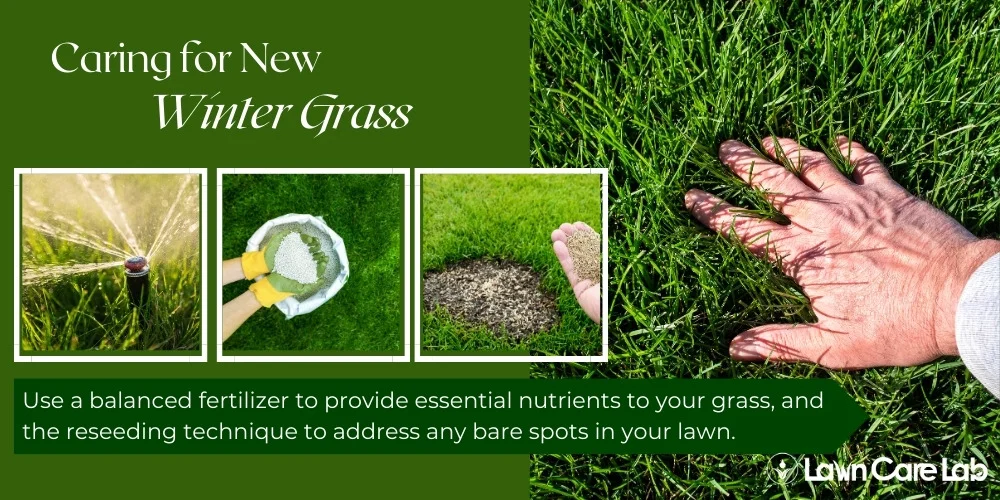
Let’s explore the importance of regular watering, even in winter, the benefits of using a balanced winter fertilizer to provide essential nutrients to your grass, and the reseeding technique to address any bare spots in your lawn.
Continue Watering
Winter lawn care is important for new grass. Keep it hydrated, even in cold conditions.
Water your lawn once or twice weekly to reach 1 inch of rainfall. Focus on dry areas and adjust watering based on weather changes.
Keeping your lawn green all year requires diligent watering.
Apply Balanced Fertilizer
Fertilizing isn’t just about nourishing your lawn; it’s about preparing it to thrive in winter.
The Nitrogen component fuels growth before the ground freezes.
Phosphorus supports root and shoots growth even in cold conditions.
Potassium enhances the lawn’s ability to withstand drought, preparing it for winter’s harsh conditions.
Choose a slow-release fertilizer to provide nutrients for 6-8 weeks continuously. Follow the product instructions carefully to ensure the best results.
Reseed Bare Spots
Reseeding barren lawn areas in early spring improves thickness when soil temperature rises above 50°F. Consistency is key.
Here’s your guide:
- Scatter additional seeds evenly over the thin patches.
- Be generous with the seed as if you’re feeding birds in the park.
- Maintain consistent moisture until the new grass sprouts.
- Consider this process as nurturing. Your lawn needs careful attention and care.
Get ready to make your lawn the envy of the neighborhood, Grassmaster! Consistent care and patience will make it lush and full.
Conclusion
Believed nurturing grass in winter was as unattainable as snowball fights in summer. You might want to reconsider!
With the correct grass variety, smart strategies, and sufficient care, your lawn can achieve a level of greenness like never before. Don’t allow winter to hinder your backyard’s aesthetics.
Embrace the cold, and let’s get started with gardening! After all, successful gardening is not confined to any season!
Frequently Asked Questions
What Are Some Common Diseases That Can Affect Grass During Winter?
Can Using Fertilizers Help in the Growth of Grass During Winter?
How Does Snow Affect the Health of Grass During Winter?
Can the Growth of Grass Be Accelerated During Winter?
What Are the Signs of Healthy and Unhealthy Grass in Winter?
- How to Create a Lawn Care Schedule for Southern Climates - October 30, 2024
- How to Use Compost Tea to Boost Lawn Growth and Soil Health - October 23, 2024
- The Best Grasses for Saltwater-Exposed Lawns: Coastal Lawn Care - October 17, 2024


